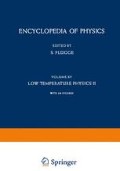Abstract
Although superconductivity falls into the domain where one would expect ordinary non-relativistic quantum mechanics to be valid, it has proved to be extremely difficult to obtain an adequate theoretical explanation of this remarkable phenomenon. In spite of the large amount of excellent experimental and theoretical work devoted to the problem, there remain major unsettled questions. However, the area in which the answers are to be found has been narrowed considerably. There are very strong indications, if not quite a proof, that superconductivity is essentially an extreme case of diamagnetism rather than a limit of infinite conductivity. The isotope effect indicates that the superconducting phase arises from interactions between electrons and lattice vibrations.
Access this chapter
Tax calculation will be finalised at checkout
Purchases are for personal use only
Preview
Unable to display preview. Download preview PDF.
General References
Bardeen, J.: Rev. Mod. Phys. 23, 261 (1951). A review of attempts which have been made to calculate electron-phonon interaction energies for application to superconductivity.
Bardeen, J., and D. Pines: Phys. Rev. 99, 1140 (1955). Formulation of the electron-phonon interaction problem, including effects of Coulomb interactions.
Burton, E. F., and others: The Phenomenon of Superconductivity. Toronto 1934.
Fröhlich, H.: Phys. Rev. 79, 845 (1950). The basic paper of Fröhlich’s theory.
Ginsburg, W. L.: Fortschr. Phys. 1, 101 (1953). A review of theories of superconductivity, with consideration of the spectrum of elementary excitations. Good bibliography, particularly of work done in USSR.
Ginsburg, W. L., and L. D. Landau: Z. eksper. teor. Fiz. 20, 1064 (1950). An extension of the London phenomenological theory to take into account a space variation of the order parameter.
Ginsburg, W.L.: Nuovo Cim., Ser. II 2, 1234 (1955).
Gorter, C. J. (editor): Progress in Low Temperature Physics, vol. I. New York 1955.
Gorter, C. J., and H. B. G. Casimir: Phys. Z. 35, 963 (1934).
Gorter, C. J., and H. B. G. Casimir: Z. techn. Phys. 15, 539 (1934).
Gorter, C. J., and H. B. G. Casimir: Physica, Haag 1, 306 (1934). Thermodynamic relations and the twofluid model.
Heisenberg, W.: Two Lectures, Cambridge, 1948. One of the lectures is a review of the Heisenberg-Koppe theory.
Koppe, H.: Fortschr. Phys. 1, 420 (1954). A review of the phenomenological theory.
Koppe, H.: Ergebn. exakt. Naturw. 23, 283 (1950). A review, based in large part on the Heisenberg-Koppe theory.
Klein, O.: Ark. Mat., Astronom. Fys. Ser. A 31, No. 12 (1944).
KleinO., and J. Lindhard: Rev. Mod. Phys. 17, 305 (1945). Calculation of diamagnetic properties of an electron gas with applications to superconductivity.
Landau, L. D.: Phys. Z. Sowjet 11, 129 (1937). Unbranched model of intermediate state.
London, F.: Une conception nouvelle de la supraconductibilité. Paris 1937. Review of phenomenological theory.
London, F.: Superfluids, vol. I. New York 1950. Macroscopic theory of superconductivity. A basic source for the present article.
London, H., and F. London: Proc. Roy. Soc. Lond., Ser. A 149, 71 (1935).
London, H., and F. London: Physica, Haag 2, 341 (1935). Basic papers of the London phenomenological theory.
Meissner, W.: Ergebn. exakt. Naturw. 11, 219 (1932).
Meissner, W.: Handbuch der Experimentalphysik, vol. 11 (pt. 2), 204 (1935).
Mendelssohn, K.: Rep. Progr. Phys. 12, 270 (1949).
Pippard, A. B.: Proc. Roy. Soc. Lond., Ser. A 216, 547 (1953). Basis for Pippard’s non-local phenomenological theory.
Pippard, A. B.: Adv. Electronics a. Electron Physics 6, 1–45 (1954).
Serin, B.: Superconductivity, Experimental Part, in this volume.
Shoenberg, D.: Superconductivity, 2nd Ed. Cambridge 1952. An excellent introduction to the subject, with a very complete bibliography.
Shoenberg, D.: Nuovo Cim. 10, 459 (1953). A review of work on superconductivity in the USSR.
Laue, M. von: Theorie der Supraleitung, 2. Aufl. Berlin-Göttingen-Heidelberg 1949. English translation by L. Meyer and W. Band, New York, 1952. A very complete account of the phenomenological theory.
Conference Proceedings (since 1949)
International Conference on Low Temperatures, M.I.T., Cambridge, Mass.
Low Temperature Symposium, National Bureau of Standards, Circular 519, Washington, 1952.
Oxford Conference on Low Temperatures.
Lorentz-Kamerlingh Onnes Conference, Physica, Haag 19, No. 9 ( Sept. 1953 ). Short papers followed by discussions.
International Conference on Theoretical Physics, Kyoto and Tokyo, 1954.
International Conference on Low Temperature Physics, Houston, Texas.
Ninth Congress of the International Institute of Refrigeration, Paris.
Conference on Low Temperature Physics and Chemistry, Baton Rouge, La. USA.
Editor information
Rights and permissions
Copyright information
© 1956 Springer-Verlag OHG. Berlin · Göttingen · Heidelberg
About this chapter
Cite this chapter
Bardeen, J. (1956). Theory of Superconductivity. In: Flügge, S. (eds) Low Temperature Physics II / Kältephysik II. Encyclopedia of Physics / Handbuch der Physik, vol 3 / 15. Springer, Berlin, Heidelberg. https://doi.org/10.1007/978-3-642-45838-5_4
Download citation
DOI: https://doi.org/10.1007/978-3-642-45838-5_4
Publisher Name: Springer, Berlin, Heidelberg
Print ISBN: 978-3-642-45840-8
Online ISBN: 978-3-642-45838-5
eBook Packages: Springer Book Archive

